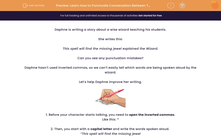Daphne is writing a story about a wise wizard teaching his students.
She writes this:
This spell will find the missing jewel explained the Wizard.
Can you see any punctuation mistakes?
Daphne hasn’t used inverted commas, so we can’t easily tell which words are being spoken aloud by the wizard.
Let’s help Daphne improve her writing.
.jpg)
1. Before your character starts talking, you need to open the inverted commas.
Like this: “
2. Then, you start with a capital letter and write the words spoken aloud.
“This spell will find the missing jewel
3. After that, we must then put a piece of punctuation before closing the speech. Our choices are:
- Commas (,) - used if the person is saying a statement
- Question marks (?) used if the person is asking a question
- Exclamation marks (!) used if the person is shouting or exclaiming
In our sentence, the wizard is making a statement so we can use a comma.
“This spell will find the missing jewel,”
Finally, we write a reporting clause which tells us who said the speech.
“This spell will find the missing jewel,” explained the wizard.

Now that looks much better!
Explained is a much more exciting word to use than said. Using said doesn’t help us to understand how a character is speaking.
Using Speech for a Conversation Between Two Characters
When we use speech to show two or more characters having a conversation, we must go onto a new line each time a different character starts talking.
Like this:
“This spell will find the missing jewel,” explained the wizard.
“Can you show me how to cast the spell?” asked the student.
“Of course. Please watch and listen closely,” instructed the wizard.

When the student started talking, we started writing on a new line.
When the wizard started speaking after the student, we started writing on a new line.
New speaker, new line.
In this activity, you’ll be following these instructions to punctuate speech correctly. Remember to use more exciting words than said.








